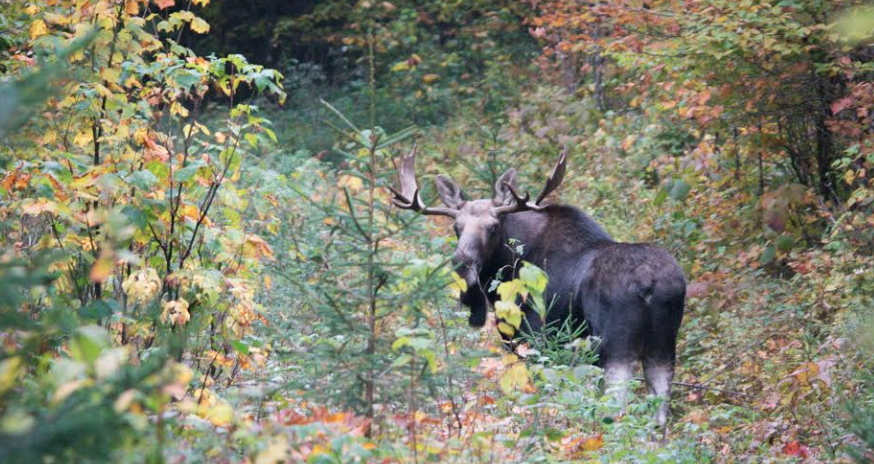This article was written by Tom Rogers, Vermont Fish & Wildlife Department. Tom will be speaking on this topic at this weekend’s Taylor Series talk. Join GMC in Enosburg Falls this Saturday, February 9th, to learn more.

In many ways, moose are the bellwether species for climate change in Vermont. The moose’s enormous bodies covered with thick scruffy fur and their knobby, spindly legs make them well adapted for cold, northern winters. Those same features, though, ensure moose don’t do well in heat. And as the planet’s changing climate leads to increasingly warm Vermont summers, moose continue to struggle. Moose begin to get heat stress at 57 degrees F and will start to pant at 63 degrees F. They slow down their feeding activity when warmer weather hits during the crucial time of year when they need to bulk up on shoots and leaves.
Other factors besides warm summer days are causing moose to struggle amid climate change. They are also increasingly bothered by winter ticks, which feed on their blood by the tens of thousands. Each spring, the winter ticks drop off the moose to lay eggs, surviving in much greater numbers on the bare, snowless ground that is increasingly common in the modern climate era. Because of more numerous ticks, moose calves are more frequently dying from blood loss and from hypothermia after they rub their insulating fur off while attempting to shed the irritating parasites. Biologists with the Vermont Fish & Wildlife Department are currently undertaking a three-year study following radio-collared moose to see what can be done to help them. However, if the climate continues to warm, moose may respond by marching northward to Canada and out of Vermont altogether.
Moose aren’t the only species forced to adjust to climate change. The timing of natural events, what scientists refer to as ‘phenology’, may be changing faster than wildlife can adapt. For example, many birds time their migration and nesting season to precisely match when buds open and insects are available to feed their young. If buds emerge early in response to warm spring weather, or if these events become unpredictable from year to year, some birds may struggle to keep up. In 2018, following a spell of particularly warm weather, biologists observed wood ducks present on open water and bluebirds exhibiting nesting behavior on February 24th – considerably earlier than a typical year.
Other strange observations include turtles out basking in the sun on Christmas Eve and bears reported out of their dens in the dead of winter. In fact, researchers have determined that for every degree Celsius temperatures rise in winter, bears will hibernate an average of six fewer days.
What are the threats?
Native species may find it difficult to adapt to the unpredictable weather or “global weirding” brought on by climate change, but invasive species typically don’t struggle so much with climate change. By their very nature, invasive species are highly flexible and adaptable. Botanists have observed that invasive purple loosestrife is blooming earlier in the spring in response to climate change, but our native cattails are not. Major flooding events (made more frequent by warming global temperatures – think Tropical Storm Irene) that tear up the banks of streams and rivers and topple trees are fantastic for invasive Japanese knotweed, which can establish new roots and quickly take over a streambank from a single fragment of a leaf or shoot. And invasive forest pests such as hemlock woolly adelgid or spruce budworm are limited in their range by temperatures, meaning as temperatures warm, these species will continue to spread northward.
Invasive species are not the only species that are shifting their range in response to climate change. In a recently published paper in the journal Science, scientists examined the ranges of more than 4,000 species from around the world. Roughly half are shifting their range already, with species on land shifting more than 10 miles per decade and marine species more than 40 miles per decade.
Forests will likely change in response to climate change too. By century’s end, models by the Union of Concerned Scientists predict that Vermont’s climate will at best be more like West Virginia’s or worse, more like the Smoky Mountains’ of Tennessee if greenhouse gas emission isn’t reduced. Clearly, very different trees and other plants are found in the forests of the Smoky Mountains than in the Green Mountains. Biologists don’t know how or if the forests will be able to adapt to keep up.
And to round out the list of threats, warmer, wetter weather is already incubating pathogenic fungi, bacteria, and viruses, in addition to increasing the numbers of mosquitos and ticks, breeding a whole host of wildlife diseases. Among the emerging diseases that may eventually threaten wildlife populations are eastern equine encephalitis, avian influenza, and snake fungal disease, which causes lumps and ulcers to form on the face, eyes, throat, and, eventually, lungs of native timber rattlers.
What can be done?
Wildlife already face major challenges from fragmentation and loss of habitat and the spread of invasive species. Climate change accelerates these threats. As a result, maintaining healthy and connected habitats is the single most important thing we can do for wildlife conservation in a changing climate. Fish and wildlife will increasingly need to move around to find the resources they need in a changing climate. So what are conservationists, and the Vermont Fish & Wildlife Department, doing about that?
First, we’re working with the Department of Transportation and other partners to make the state’s transportation infrastructure – our roads, highways, bridges, and culverts – more permeable to wildlife, allowing them to freely and safely move across the landscape.
Second, we’re taking a statewide approach to maintaining a diverse and connected network of habitats that species require to adapt to climate change and other conservation threats. Referred to as Vermont Conservation Design, staff biologists are working with interested landowners and on state lands to make informed conservation decisions with climate adaptation in mind. This effort was codified in the recent New England Governors and Eastern Canadian Premiers Resolution on Ecological Connectivity, with regional state and provincial leaders committing to maintaining healthy and connected forests and waters to maintain biodiversity in response to climate change.
Landowners looking to join in the effort should contact Vermont Fish & Wildlife to connect with their local biologist or forester and find out about maintaining healthy wildlife habitat on their land. The local land trust or statewide land trusts such as The Nature Conservancy or Vermont Land Trust can help provide information about placing a conservation easement on property to keep it open for future generations. And town planners or conservation commissions can connect with the department’s conservation planning biologist to help maintain the places in their community they value and to help preserve our way of life in Vermont. Efforts undertaken to adapt to climate change benefit wildlife, but they also benefit communities, providing increased flood protection and protecting drinking water sources.
Every management action taken at the Vermont Fish & Wildlife Department today, whether buying land, protecting wildlife habitat, planning with the public, or managing game species such as deer or wild turkeys, is undertaken with climate change in mind. By working together, we can ensure that Vermont remains a place where wildlife remains healthy and abundant despite the challenges of climate change.



















This is a frighteningly thorough overview!